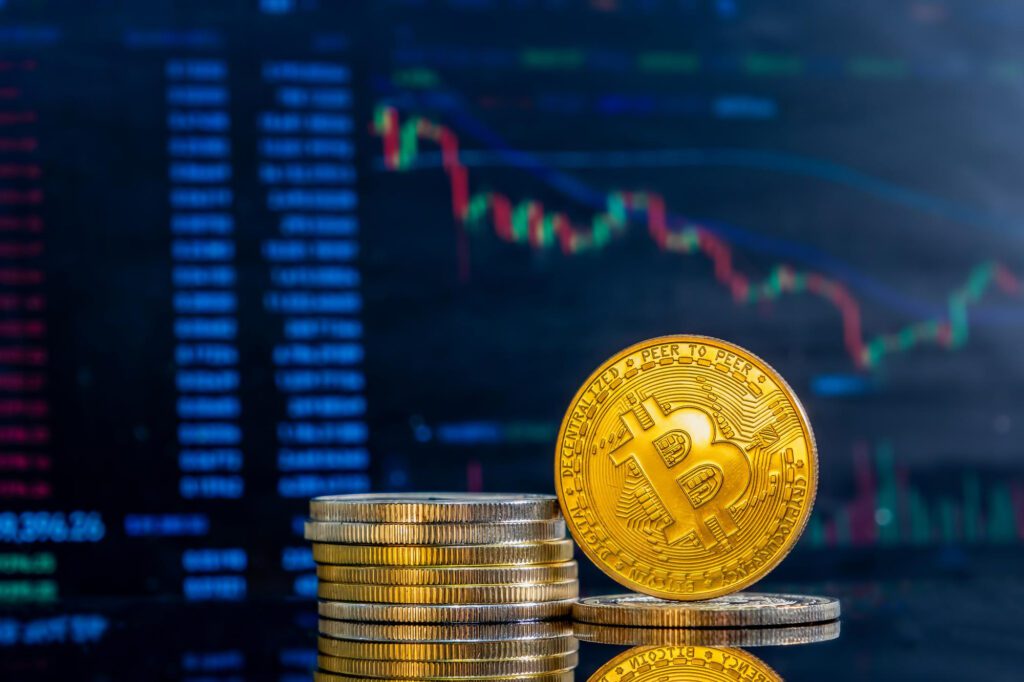

Launched in 2009 by some mysterious developer known as Satoshi Nakamoto, Bitcoin(BTC) is the world’s first and most valuable cryptocurrency. It has a market cap of a staggering 424.82B, which is more than that of companies like Johnson & Johnson, JPMorgan Chase, Walmart, Coca-Cola, and many more. But how a digital currency like Bitcoin without any physical presence has acquired so much market cap? Why so many people have started investing in Bitcoin? While some say it is the greatest technological breakthrough, others dismiss it by saying it is a scam. To understand whether Bitcoin is really the future of finance, we need to start from the basics.
What is money?
At its core, money is a medium of exchange. It represents value. You can exchange money to avail the goods and services that are valuable to you.
Let’s take a simple example. Person A grows apples and person B grows bananas. Now, if A needs Bananas and B needs Apples, they could just exchange Apples with Bananas directly. However, if B doesn’t need Apples or A doesn’t need Bananas, then how to settle the exchange? Then they need a different method of exchange that both A and B can agree on. Here comes the money. Throughout history, people have used different materials like salt, wheat, shell, silver, and of course gold to represent money.
What gives money its value? The gold standard:
Trust is the underlying pillar that gives money its value. For any medium of exchange to work, people need to trust the system. They need to believe the medium of exchange to be valuable and it will remain valuable in the future so they can redeem that value later.
Over time people found it inconvenient to carry around gold bars to make any sort of transaction. It is also difficult to cut the gold bar into small pieces to pay for small exchanges. That’s when paper money was introduced. Every piece of paper money such as a dollar or pound used to be backed by a certain amount of gold. For every paper money, the government or the central bank had to ensure equivalent gold in their possession. So, you could exchange your paper money for an equivalent amount of gold anytime from the bank. This is the gold standard of money.
The gold standard ensures that government can not simply print new paper money whenever they wish. Printing new money will not create the underlying value (in this case, gold), thereby reducing the value of money.
Why was ‘the gold standard’ ditched?
Suppose a government has a huge debt of $1 million. In the gold standard, the government needs to earn that $1 million through taxes or trades to pay that debt. However, they soon found a shortcut. They can simply go to the backroom, print $1 million in paper money and pay the debt. The gold standard did not allow that, so they had to get rid of the gold standard. You might feel betrayed because the moment government prints more money, the underlying value of your paper money decreases. But, this is sadly how most countries pay their debts, causing inflation as a byproduct. Soon the ‘gold standard’ was dropped by most governments. This made paper money a fiat currency.
Does any country still follow the ‘gold standard’?
No. As of 2023, no countries in the world follow the gold standard anymore.
What is fiat currency?
Fiat currency is a government-issued currency that does not have any underlying value (such as gold), and is instead backed fully by the trust in the government’s promise. Today, all established currencies like Dollar, Pound, Rupee, Euro, and Yuan are fiat currencies.
Back in the day, you could trade in gold because you knew, gold is valuable by itself, without any promise from anybody. However, in the case of fiat currency, it has value because the government says so. That’s why you will see a signature by the central bank on your currency note that promises the value.


But if tomorrow, the government comes and declares that your $100 bill has no value, then you are screwed. That $100 bill in your purse is nothing but a piece of paper now. This is called demonetization, and it is real.
Key drawbacks of fiat currency:
- Fiat currency is centralized. The government and central bank have full authority over the currency. The govt can freeze your account, deny access to your account, or worse can demonetize currency.
- It has an unlimited supply. Government can print any amount of money whenever they want. For example, the US government printed over $3 trillion during the Covid in 2020. The problem with printing money is that the value of each dollar drops as more currencies come into circulation. So your own money will be worth less in the next year.
- High fees and limits. Banks often set withdrawal limits on your own money. When it comes to transferring money in a foreign country, they often charge a crazy amount of fees.
So now that we understand the fundamental problems associated with centrally managed fiat currency, let’s try to understand where Bitcoin finds its place.
What is Bitcoin?
Introduced in January 2009 by a group of programmers under the pseudonym Satoshi Nakamoto, Bitcoin is the world’s first cryptocurrency. It is a fully digital and decentralized currency that exists on the blockchain and is secured by cryptography. It is fully digital meaning it exists electronically. You can not hold a bitcoin physically. It is decentralized, meaning there is no central authority (like a bank or a government) that controls Bitcoin. So no organization decides when to print Bitcoin, how much to print, who owns how much, or investigating fraud. It is secured by cryptography, a sophisticated algorithm that ensures only genuine transactions are added to the block and prevents anybody from tampering with it. To understand in depth all the fundamental concepts associated with Bitcoin and Cryptocurrency in general, I highly recommend you to go through my article A Beginner’s Guide to Cryptocurrency – Everything You Should Know.
Why is Bitcoin valuable?
The fundamental idea behind introducing Bitcoin is to eliminate the idea of keeping full faith in the government or central bank. Faith in the government has declined in most countries. People are worried that the government can simply print more fiat currency and devalue it. Most countries are already struggling with high inflation due to this. Every hard-earned dollar that you save today will have less buying power next year. So, people needed a different repository of value that the government can’t manipulate. That’s where Bitcoin comes in.
Bitcoin is an alternative to fiat currency that no government or bank controls. You can think of it as a traditional medium of exchange (like gold) where enough people believe that it is stable enough and accept it as a currency with some inherent value. Bitcoin provides a new financial system where you don’t rely on the government’s ability to manipulate or stimulate the currency, print, or demonetize it. Instead, you believe in a system that is trusted by other people.
Bitcoin has a similar economic profile as gold. The maximum supply of Bitcoin is capped at 21 million. Only a few Bitcoins are created every day and that number reduces by half every four years. Basic economics dictates if something has a limited supply and increasing demand, the price will increase.
You can argue if tomorrow people decide not to use bitcoin anymore, or businesses decide not to accept Bitcoin as a payment, the value of Bitcoin could go to zero. But that is highly unlikely given the rising adoption of Bitcoin. Moreover, the government doesn’t have the power to make Bitcoin worth zero. It can not be controlled by any central entity. People don’t have to worry that the creators will print new bitcoin and manipulate the value. This is the foundation of trust that people have in Bitcoin. The more people buy Bitcoin, the more valuable it is. In that sense, it is no different that gold except for the fact that Bitcoin is an entirely digital asset. This is how Bitcoin is valuable.
Bitcoin vs Banks
| Bitcoin | Banks |
| Bitcoin’s ledger is transparent. That means anyone can take a look at Bitcoin’s ledger and see all the transactions that are taking place. | Bank’s ledger is not transparent. It is stored by the bank and no other person can see the transactions. Bank has full control over it. |
| Ensures privacy. Even though everyone can see the transactions, there is no way you can figure out who is making those transactions and to whom. | Banks have all the personal details of their customers. So, all transactions can be traced back to the individual level. |
| Bitcoin is decentralized, meaning no central authority can freeze your wallet, block transactions, or manipulate the value. | Banks are centralized, central banks and government have full authority to freeze your account, block transaction, and print currency notes to manipulate the value. |
| Bitcoin transactions are cheaper and faster especially when you are sending them abroad. | International transactions through banks require high fees and time as it involves multiple intermediaries. |
| Bitcoin has a finite max supply, thereby protecting the value of Bitcoin. | Fiat currency has an infinite supply. Government can print money anytime they wish, thereby causing inflation. |
| Being decentralized, Bitcoin is highly secure. All the computers in the network have a copy of Bitcoin’s ledger. So to tamper with any transaction, the hacker needs to take control of more than 50% of the computer at the same time, which is almost impossible for a huge network like Bitcoin. | Banks, on the other hand, store all their information in a centralized location. This makes them much more vulnerable to hacks and fraud. |
Is Bitcoin a replacement for fiat currency?
No, Bitcoin is not a replacement for fiat currency at this moment, however, it is a possibility in near future. Right now, Bitcoin works more as a digital asset or repository of value like Gold. Though some businesses have started accepting Bitcoin and other cryptocurrencies as payment, it is still very limited. It is still very early when it comes to Bitcoin adoption. To become a truly global currency, Bitcoin needs to be adopted at a much larger scale.
It is difficult to say when digital assets like Bitcoin transactions become mainstream. But the steep adoption curves show that day may not be very far away. That said, it will be a tough challenge to be recognized as a currency by the government since they will be reluctant to give up their control. It will be interesting to watch how that plays out over the next decade.
The future of Bitcoin
The year 2022 turned out to be the worst for cryptocurrencies in general. The crypto market has lost a little over $2 trillion in 2022, and many exchanges like FTX, 3AC went bankrupt. Bitcoin fall over 70% compared to its all-time high in Nov 2022. SEC keeps cracking down on multiple cryptocurrencies and companies.
While this crypto winter is disappointing to many, others believe this will hand over crypto technology and blockchain infrastructure to steadier hands, similar to what happened during the dot-com bubble burst in the early 2000s. There is no denying that the underlying technology of cryptography and blockchain is revolutionary across all the industries like core financial services, logistics, Web3, storage, logistics, security, and many more. Many big banks like Morgan Stanley, Goldman Sachs, and JPMorgan all have started adopting crypto and blockchain.
Bitcoin has seen rapid adoption since its inception in 2009. Even though it was initially used in illegal dark web activities, it has seen significant mainstream adoption in recent times. That trend is only going to go up. Today, there are over 81 million Bitcoin wallets are there. Apart from banks, El Salvador and the Central African Republic (CAR) have recognized Bitcoin as legal currency. Few other countries have shown pro-crypto sentiment towards Bitcoin as a currency.
As of now, Bitcoin works more as a store of value, a digital asset. Due to technical limitations, the Bitcoin network can not handle millions of transactions in a short time. To become a truly global currency, it needs technological improvements in its ecosystem. The good news is, the Bitcoin network supports layer-2 solutions that add additional functionalities to the Bitcoin blockchain. One such example is Lightning Network, a “layer 2” payment protocol layered on top of Bitcoin. It is intended to enable fast transactions among participating nodes and has been proposed as a solution to the bitcoin scalability problem.
Bitcoin adoption is only going to accelerate as more and more people lose faith in their government and the central authority. As more people adopt Bitcoin, it will become less volatile, its ecosystem will improve and it will become more suitable to function as a currency. So the next decade is going to be very interesting to watch how everything plays out.
Flipsides of Bitcoin:
- As Bitcoin gains more adoption, more people will switch to investing in such digital assets as a safer repository of value compared to government debt and bonds. That means the government will have a hard time raising money from people to fund different projects.
- Bitcoin transactions are completely anonymous. That makes it popular in the black market and among criminals.
- Bitcoin is still a highly volatile asset. To work as a currency, its value must stabilize through wider adaptation.
- There are thousands of other cryptocurrencies out there. No one can say for sure if some other cryptocurrency will replace Bitcoin in the future.
- Being an unregulated asset class, Bitcoin investors often fell prey to scams and frauds.
Conclusion:
Launched in 2009 by some mysterious developer known as Satoshi Nakamoto, Bitcoin (BTC) is the world’s first and most valuable cryptocurrency. It is a fully digital and decentralized currency that exists on the blockchain and is secured by cryptography. The fundamental idea behind introducing Bitcoin is to eliminate the idea of keeping full faith in the government or central bank. Bitcoin provides a new financial system where you don’t rely on the government’s ability to manipulate or stimulate the currency, print, or demonetize it. Instead, you believe in a system that is trusted by other people. Bitcoin has a similar economic profile as gold limited by its maximum supply of 21 million. Contrary to the traditional banking system, Bitcoin is decentralized, transparent, and inflation-proof. Bitcoin is not a replacement for fiat currency at this moment; however, it is a possibility in the next 20-30 years. El Salvador and the Central African Republic (CAR) have adopted Bitcoin as a legal currency. Many banks have started adopting crypto and blockchain into their core financial services. As more people adopt Bitcoin, it will become less volatile, its ecosystem will improve and it will become more suitable to function as a currency.








